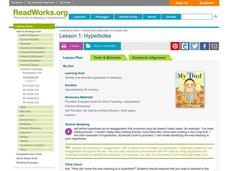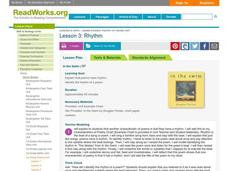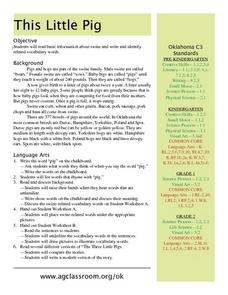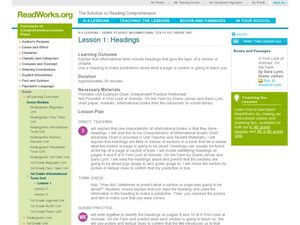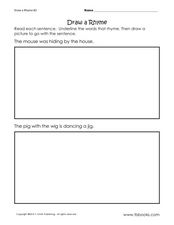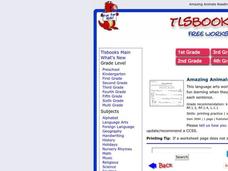Curated OER
Oral Stories
Legends are stories that have been retold as they have been passed down through the generations. Learners orally retell The Legend of the Bluebonnet in their own unique way after discussing the importance of oral traditions and...
Curated OER
Lesson 2: Chronological Order
Examining life events is a great way to learn about chronological order. Sequencing and time order are analyzed after reading a book about Rosa Parks. With a chart, the class works together to put the events from Mrs. Parks' life in the...
Curated OER
Significant Contribution
Examine the lives of people who have made a significant contribution to society. The concept of biography is discussed with the class; they identify important actions, and read passages about Sacagawea and Benjamin Franklin. They write...
Curated OER
Explanatory Myths Lesson
A myth is a story that explains something in nature or society. Dive into the study of mythology as you read The Golden Flower with your class. Charts are used to define the characteristics of myths as well as to determine the main point...
Curated OER
Strategies for Determining the Meaning of a Word
What does that word mean? I can sound it out, but it just doesn't make sense. Teach your class a sure fire strategy to combat those pesky unknown words. You'll introduce the concept of context clues through metacognitive modeling,...
Curated OER
Lesson 1: Effects
If You Give a Mouse a Cookie is a perfect book to use when your class is ready to learn about cause and effect. They consider the meanings of the words cause and effect as you read the story. Working together you'll identify, discuss,...
Curated OER
Causes
Things usually don't happen without a reason; usually any event has a cause that got the ball rolling. The book, If You Give a Mouse a Muffin is used to help learners understand the concept of causes in literature. Examples from the...
Curated OER
Lesson 3: Cause and Effect Relationships
The Gunniwolf is a book full of events that get kids asking why and what. They note several events on a chart, and then discuss how they think the instructor is able to determine the causes and effects they find. They continue reading...
Curated OER
Hyperboles
Want to see the best lesson is the entire universe? Who doesn't love to exaggerate now and then? Get your class cozy with hyperbole as you read the story My Dad by Anthony Browne. During the reading you'll chart and analyze the...
Curated OER
Nature
Discuss what makes a myth with your class as you read two titles that exemplify the genre. Two myths that explain events in nature are read and charted, focusing on details from the text. The lesson culminates in a practice activity...
Curated OER
Rhythm
One of the most fun characteristics of a poem is rhythm! Little ones will clap along as you read a poem, to determine the rhythm of the piece. The book In the Swim is used throughout the lesson; it contains fish themed poems that kids...
Curated OER
Identifying Problems and Solutions in the Story
Students explore story structure. In this Groundhog's Day story structure literacy lesson, students listen to the story Groundhog Stays Up Late by Margery Cuyler, then pause half way through the story to identify the problem and...
Curated OER
Identifying When Using Evidence from the Text
First listen to the story The Meanest Thing to Say and then answer question regarding when the story takes place. Using evidence from the text, text clues and pictures to order events and find the time frame of the story is what this...
Curated OER
See, Say, Write and Read
For this simple writing worksheet, students will read and write the words see, girl, and boy. Then students will complete two simple sentences about the boy and girl.
Curated OER
This Little Pig
First graders study basic information about swine. They write and identify vocabulary words relating to the subject. They write a recipe for "Pigs in a Blanket," using canned crescent rolls and small sausages. They trade recipes and...
Curated OER
Plant Parts We Eat
I bet the kids in your class will love to eat their vegetables after an engaging lesson plan about edible plants. They read information about vegetables and edible plants, sort vocabulary words, identify plant parts, measure and graph...
Curated OER
Garden Grid
Basically, your class reads about different garden plants from an included handout and seed packets that you provide, and then uses a grid to plan out where to place the plants. They can practice counting with the seeds, grouping,...
Curated OER
Text Clues and Background Knowledge
Teach youngsters how to evaluate background knowledge, pictures, and context clues to draw a reasonable conclusion about a story. They practice using the discussed clues as they read the story, Alexander and the Terrible, Horrible, No...
Curated OER
Headings
First graders discover how heading help us make predictions. The class discusses how informational text typically has heading that can aid them in determining what a chapter will be about. They read the heading and make predictions for...
Curated OER
Reading Readiness
Get those first graders ready to read with the words monkey, long, jump, and read! They use each of the mentioned words to complete each of the four fun sentences. They read the sentences, determine which word fits best in each, and then...
Curated OER
Draw a Rhyme
In this draw a rhyme worksheet, students read 2 sentences, underline the words that rhyme in each sentence, and draw pictures to accompany each sentence.
Curated OER
Amazing Animals
What do the words dog, drink, play, and sitting have in common? They are the words that little ones will use as they read and complete four different sentences. They can use and color the helpful images related to each sentence after...
Curated OER
My Animal Book
Don't you just love resources you can print and use? Here is a complete printable packet all about animals. Kids can color the animal pictures, answer animal questions, and complete the animal crossword puzzle, then put them all together...
Curated OER
Action Words
For this action words worksheet, students read the 9 sentences and identify the action word or verb in each them. Students print their answers on the lines provided.










